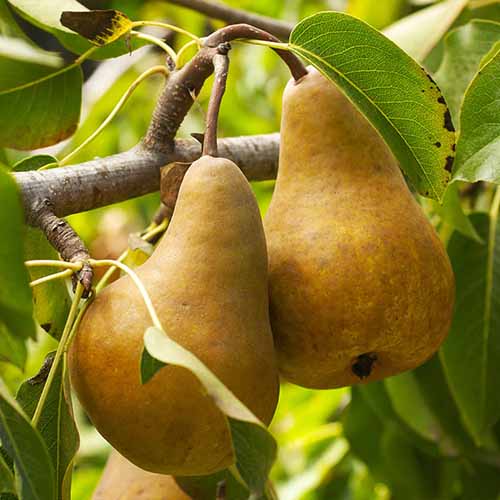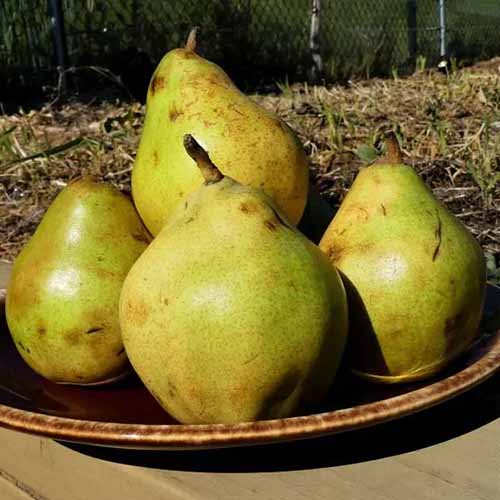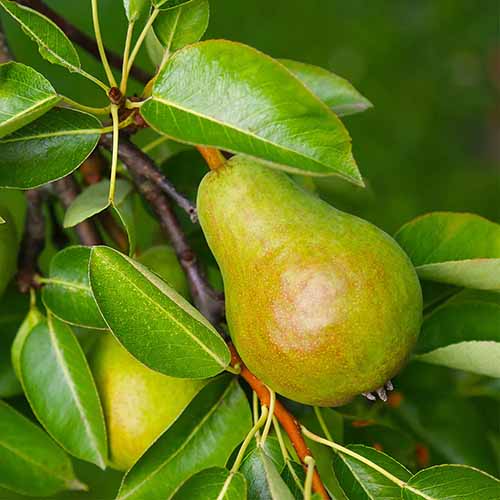Sure, there’s a lot to love about the holidays. Family, friends, annual traditions, and special foods are some of my favorite things.
And when it comes to food, winter pears are near the tippy-top of my list.
It’s not just that they’re delicious, though they are, but that they’re also a limited time treat. You can’t find a sweet, pungent, juicy winter pear in the summer. Their domain is the wintertime.
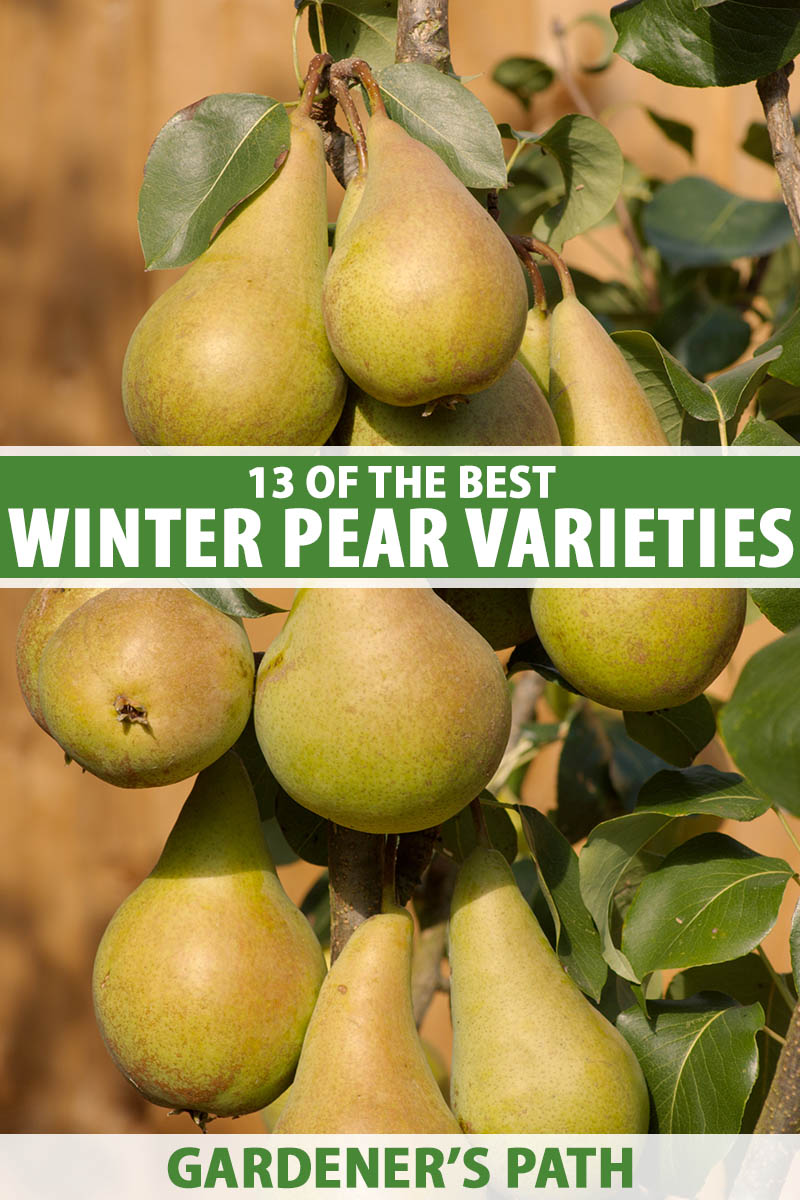
We link to vendors to help you find relevant products. If you buy from one of our links, we may earn a commission.
Pears don’t ripen on the tree. They’re one of the few fruits that don’t do this.
If we leave them on the tree to ripen, they will become soggy in the middle when the outer part of the flesh is just reaching ripeness.
So, we harvest pears when they’re mature and then allow them to slowly ripen off the tree.
Done right, the result is a sweet fruit that is unlike anything else. My mouth is watering just thinking about it.
If you need a refresher on how to grow pears at home, check out our guide.
In this guide, we’re going to talk about some of the best winter pear options. Here’s the ones we’ll discuss:
13 of the Best Winter Pear Varieties
If you aren’t sure what the difference is between a winter and a summer pear, please visit our guide, which explains it all.
Remember that these trees need a friend for pollination.
If you aren’t familiar with pear pollination, check out our full guide on the topic. We’ll tip you off to a few good pairing options, coming right up.
All of the cultivars on this list are suitable for Zones 4 to 9 unless noted otherwise.
First, we’ll start with the perennial fave:
1. Bosc
Let’s talk about the granddaddy of winter pears. Also sold under the name ‘Kaiser,’ ‘Bosc’ fruits are easily recognized by their hard, cinnamon-colored skin, long, tapered necks, and large, rounded bases.
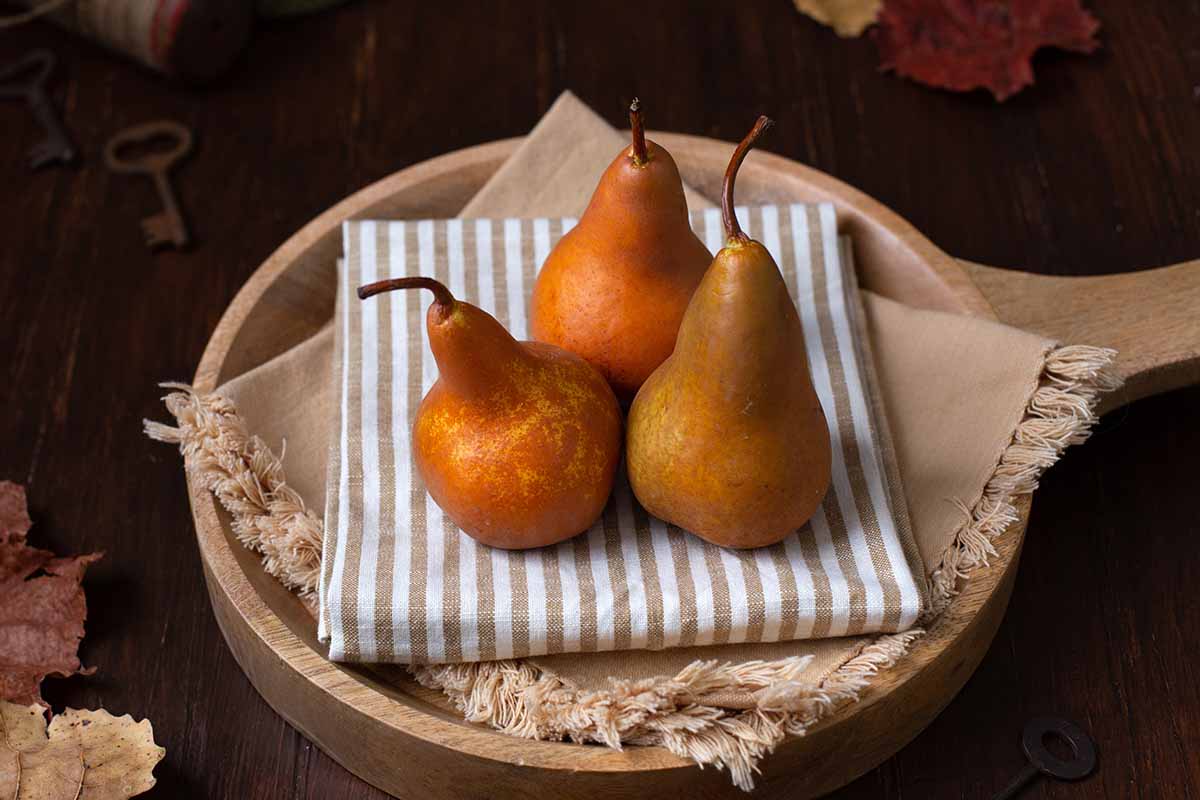
They were first named in the early 1800s and have been cherished ever since.
They famously appear in paintings and photos because of their beautiful shape and color. But we aren’t growing them just to admire their admittedly fabulous form.
These fruits aren’t just a pretty face. The flesh is crisp and more dense than that of other winter types, even when ripe. The sweet, balanced flavor has just a hint of spice.
If you like poached or baked pears, this cultivar is one of the best options. It’s also one of the longest lasting in storage thanks to that thick skin and dense flesh.
If you aren’t already running to your nearest fruit tree retailer, the fruit sweetens enough on the tree that you can eat it straight away or put it in cold storage for a softer, honey-sweet treat in a few weeks.
Okay, after waxing poetic about them, I’m about ready to tear out some of my past-their-prime lilacs and plant a ‘Bosc’ or two. Are you with me?
Pick up a semi-dwarf tree in three- to four-, four- to five-, or five- to six-foot heights at Fast Growing Trees.
Plant yours with an ‘Anjou’ or ‘Comice’ as a pollination pal.
2. Comice
If you’ve ever received a gift basket during the holidays that included a selection of pears, ‘Comice’ was probably among them.
These stand out thanks to their short necks and big, round bodies. Just be careful with them. They have thinner skin than some of their other winter friends.
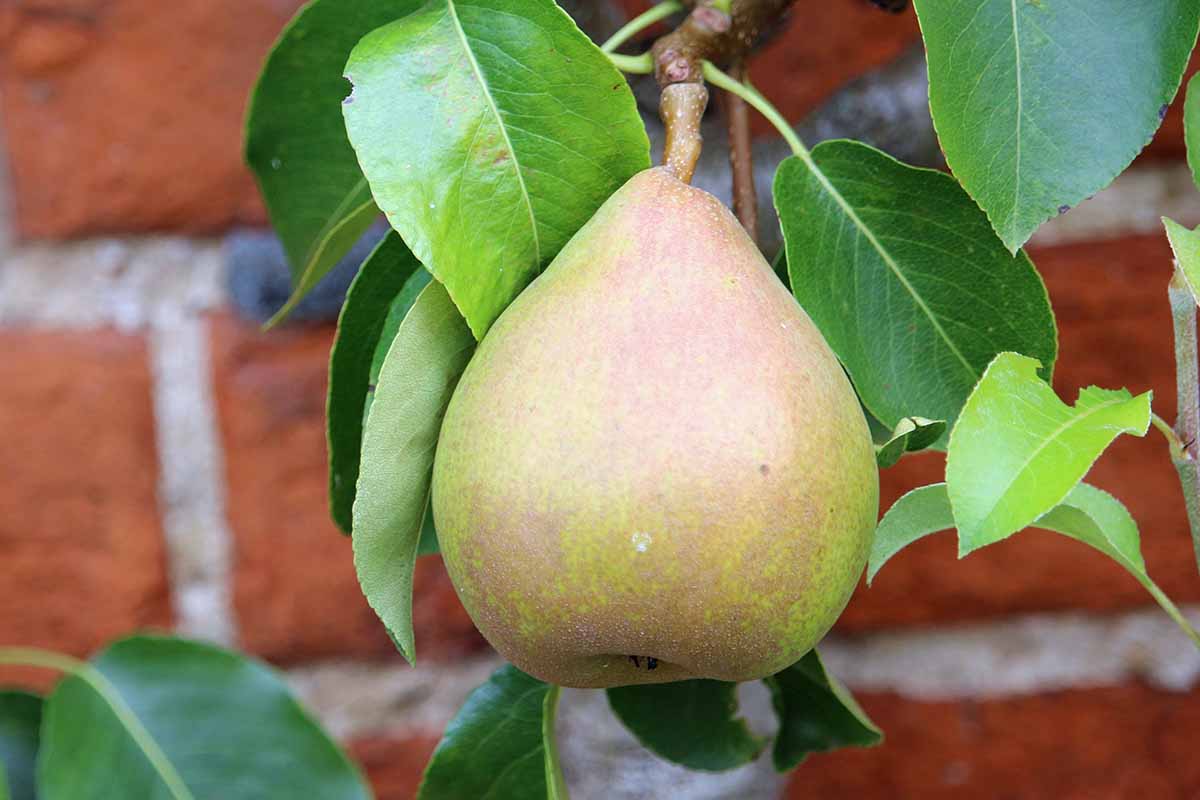
Originally, ‘Comice’ fruits were mostly green with just a hint of blush when mature.
But as breeders have refined the cultivar, many new strains are more red than green thanks to a red sport discovered in southern Oregon.
I think the best thing about ‘Comice,’ aka ‘Doyenne du Comice,’ is that the flesh practically has the consistency of cream when it’s ripe. It’s not bland, though. It has a sweet, slightly citrusy flavor.
These are an excellent choice for fresh eating since they’re extremely juicy. This same juiciness makes them less than optimal for cooking.
‘Comice’ pollinates well with ‘Bosc’ and either type of ‘Anjou.’
If you’re looking for a fresh eating option that doubles as the perfect addition to your holiday gift baskets, grab a four- to five-foot tree from Nature Hills Nursery.
3. Concorde
‘Concorde’ stands out because of its unusual shape. It has a long, slender neck and long, narrow base.
It would look beautiful paired with squat ‘D’Anjou’ in a bowl for an interesting contrast in shapes.
This cultivar was produced by breeding ‘Conference’ and ‘Comice’ in 1968.
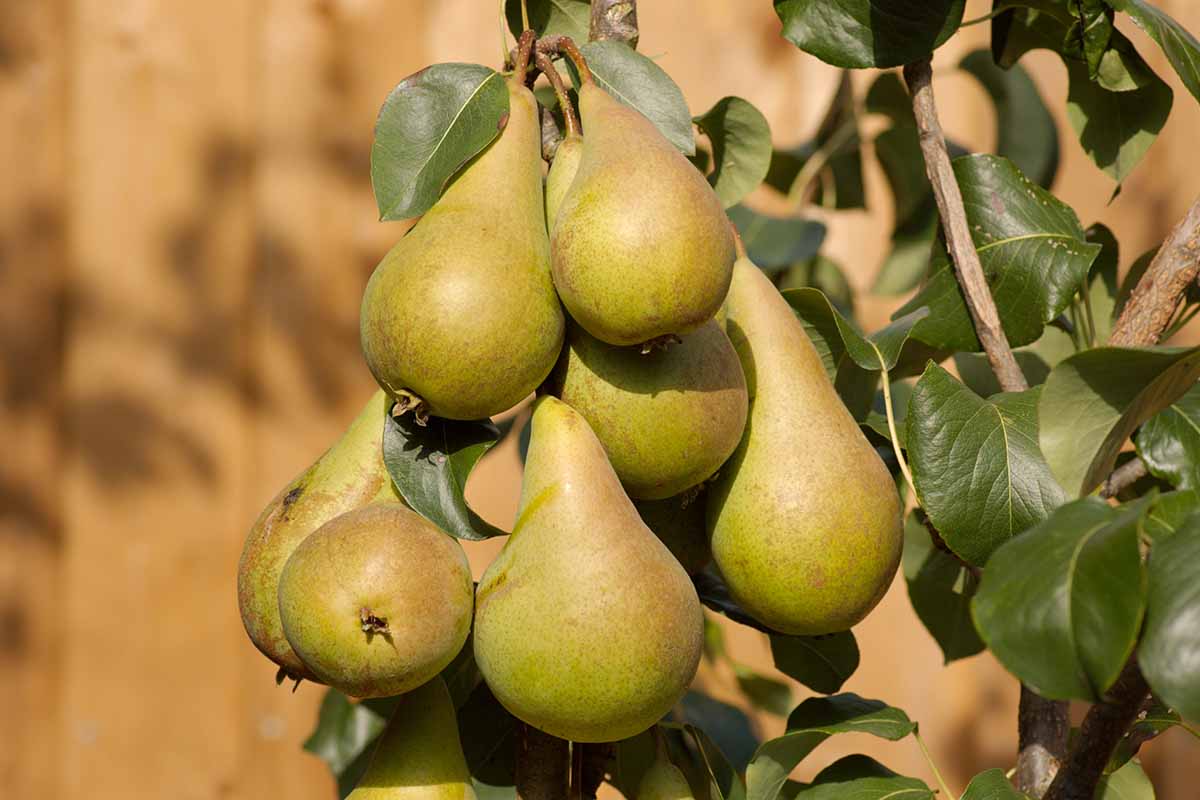
Right off the tree, it’s crisp and sweet, mellowing out as it softens in storage.
For a fruit with a pungent, classic pear flavor, ‘Concorde’ is one of the best. It has an incredible taste that makes this somewhat fussy tree worth growing.
‘Concorde’ is partially self-fertile, but you’ll get more fruit if you grow it with a friend. Something like ‘Bartlett’ or ‘Winter Nelis’ is ideal. This tree is only hardy down to Zone 5.
4. Conference
With its golden, speckled fruits, ‘Conference’ makes a pretty picture. It’s crisp and bright off the tree but mellows in storage, with spicy-sweet flesh.

This variety is better cooked while it is still a bit unripe because it becomes extremely soft and juicy when fully ripe.
Bred by noted nurseryman Thomas Rivers of Rivers Nursery in Hertfordshire, England, ‘Conference’ is resistant to disease and produces reliably, so long as it has a pollinator friend like ‘Winter Nelis’ or ‘D’Anjou.’
5. D’Anjou
‘D’Anjou’ are also called ‘Anjou’ and ‘Beurré d’Anjou’ after the city of Anjou in France, where they were discovered.
The beurré part of the name is the French word for butter, which describes the luscious texture of the ripened flesh.
There are two different ‘Anjou’ pears, and they only differ in color.
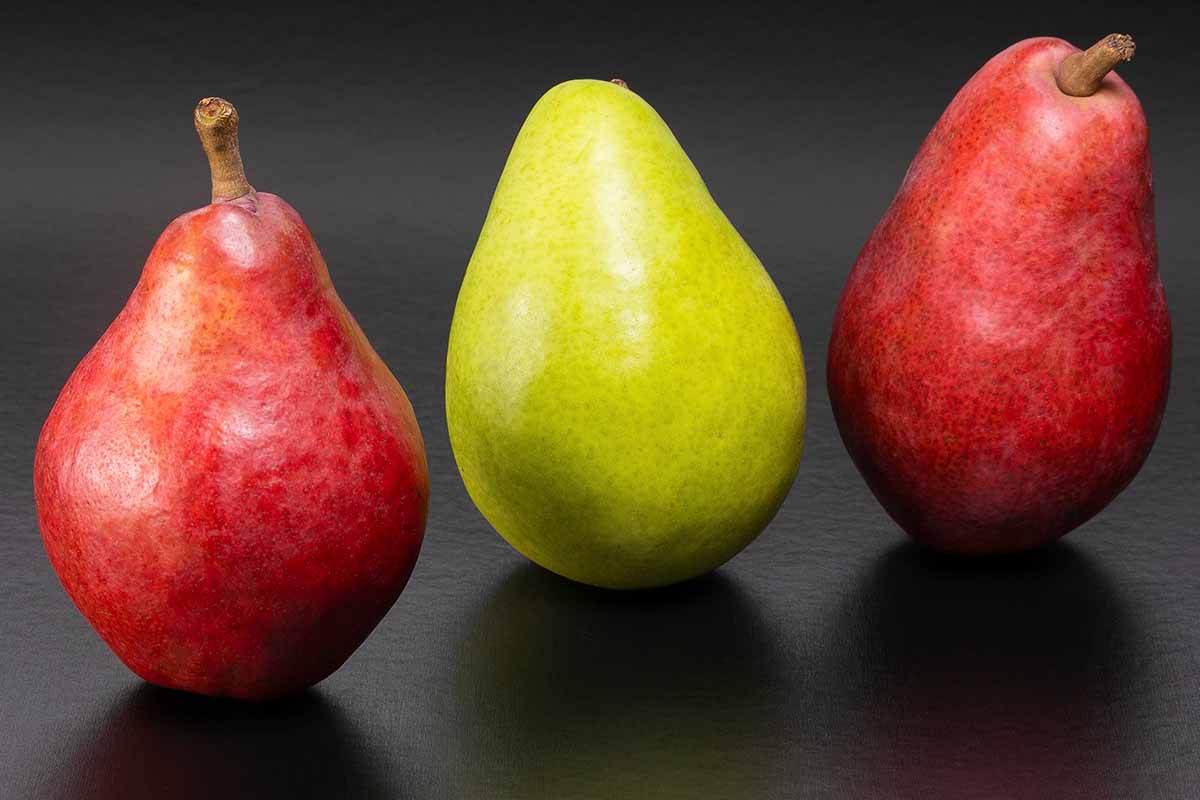
Reds are a sport of the original green variety that was discovered at two separate points: the first one was found in the 1950s in Medford in Southern Oregon and then another sport was found in 1970 in Parkdale Oregon, which sits on the slopes of Mount Hood in the Cascade Range.
Sports are naturally occurring variations, which means finding one is a big deal. But finding two variations of the same type? You could say it was meant to be.
Both colors have short, nearly non-existent necks. They look more like an elongated apple than your typical European pear. They’re usually described as egg-shaped.
Red types can range from deep maroon to greenish-red, depending on the strain. Green types are generally all green or have a subtle blush hue.
Both are mildly sweet and work well both fresh and cooked. If you like pear crisp, I couldn’t recommend a better one.
If you prefer to roast or can your fruit, ‘D’Anjou’ is great for that too. It’s an all-purpose fruit.
The trees are resistant to fire blight, so if this is a concern in your area, bring this one home. For the green type, visit Nature Hills Nursery.
‘D’Anjou’ is partially self-fruitful, so you don’t technically need to plant a second tree with it, but you’ll get more fruits if you do. ‘Comice’ and ‘Bartlett’ make good partners.
6. Forelle
‘Forelle’ fruits are small, and I mean that in a good way. They’re the perfect snack or bite-sized treat either fresh or cooked.
They also stand out from their other pear friends thanks to their red speckles. These speckles are known as lenticels, and these are growths that facilitate the exchange of gas.
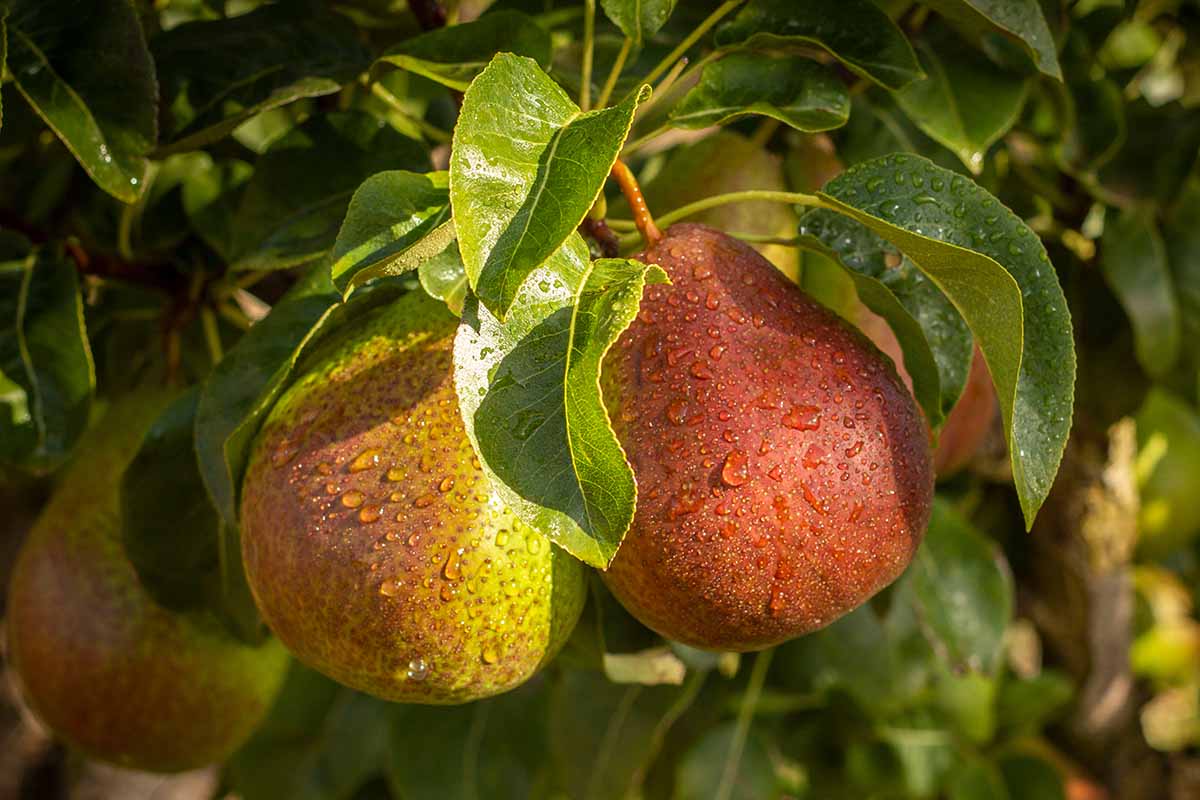
If that sounds like something you don’t need to know to raise these trees, just understand that lenticels can be a reliable indicator of when to harvest the fruits. When the lenticels are large and brightly colored, they’re ready.
Pears can be challenging to harvest because it almost takes a sixth sense to know when they’re mature, so we’ll take all the help we can get, right?
This variety hails from Germany and arrived in the US around the early 1800s.
Underneath that speckled green and blush skin lies buttery flesh that has a mild, sweet flavor with a hint of spice.
It’s not quite as cold hardy as other trees and should be grown in Zones 5 and up.
7. Highland
Botanist Dr. George Oberle bred ‘Highland’ out of ‘Bartlett’ and ‘Comice’ in 1944.
It showed promise, and after years of testing at Cornell University, it was released on the market in 1974 and named after the location of Cornell’s Hudson Valley Lab in upstate New York.
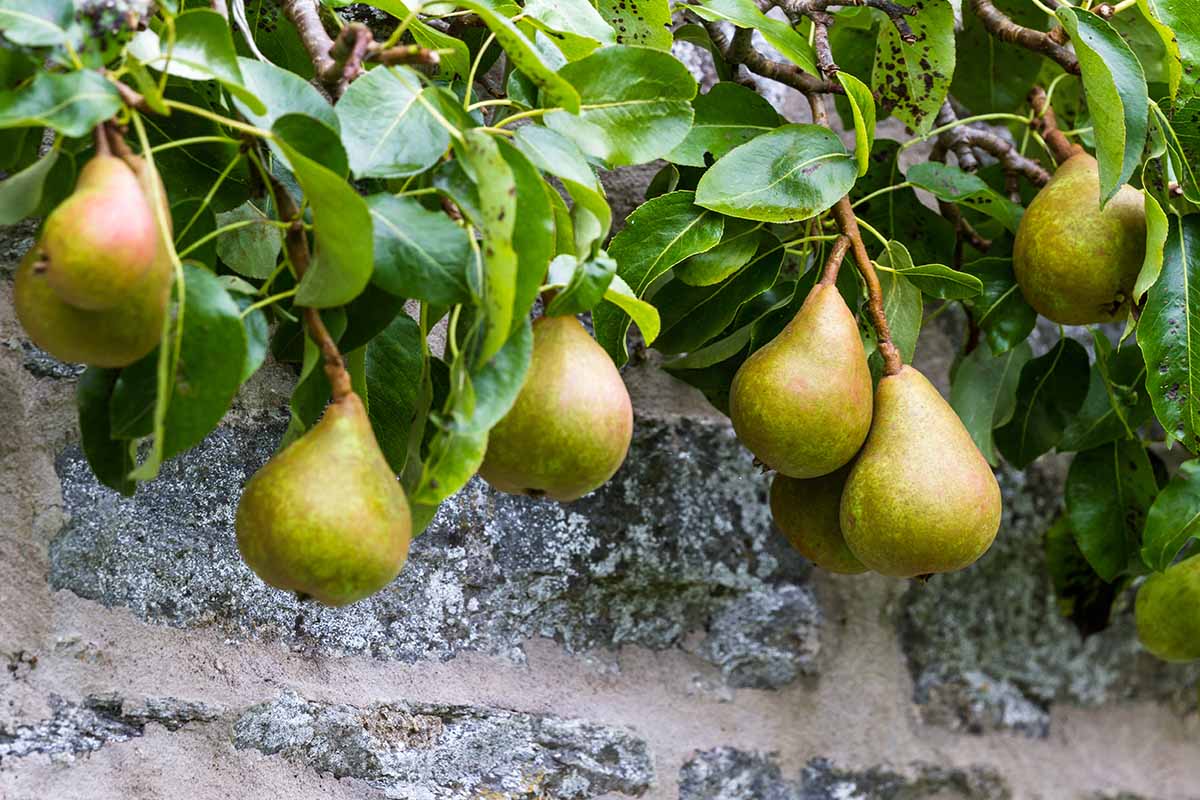
The yellow skin wraps around smooth, sweet, juicy flesh, and the fruit stores for several months with no trouble.
This cultivar isn’t as common as some of the others on this list, but it’s an excellent option if you can find it, particularly if you prefer to eat your fruits fresh or want a killer dessert option.
Plant with a ‘Bartlett’ or a ‘D’Anjou.’
8. Magness
Dr. John R. Magness led the USDA’s pear and apple breeding programs for two decades starting in 1930.
This pear was named in his honor, and it’s a worthy homage. It was first introduced to the market in 1960 by the USDA, and it was created by breeding ‘Comice’ and ‘Seckel.’
The large, elongated fruit has a golden-yellow base with blush accents. The thick skin protects a perfumed, buttery skin that is perfectly sweet straight off the tree without storage.
You can also pick them just before they’re ripe and allow them to finish ripening in storage in the traditional way for winter pears.
This tree is exceptionally vigorous and disease-resistant, but only cold hardy to Zone 5.
Triploid trees are known for being productive and tough, but though this tree isn’t a triploid, it acts like one. Plant it with ‘Bartlett’ or ‘Comice’ and prepare for the harvest.
9. Orcas
If you don’t like any graininess in your pears, pick this one.
The pretty yellow and blush skin looks gorgeous, and the pungent, sweet, crisp flesh that mellows to a buttery texture lends itself both to fresh eating and cooking.

This tree hails from Orcas Island in Washington, where it was found by horticulturalist Joe Long in 1972.
After sending it to Mount Vernon to be tested, ‘Orcas’ hit the market in 1986 and became a big hit for growers in the Pacific Northwest thanks not only to its fantastic flavor, but for its impressive disease resistance as well.
It works well with ‘Bosc’ as a pollinator.
10. Rescue
Don’t try this pear unless you have enough room to add it to your yard. Once you taste it, you’ll be ruined for other varieties.
Before I moved to the pear growing capital of the US, the Pacific Northwest, I’d never seen or even heard of it.
I picked one up at the farmers market a few years ago, and it was love at first bite.
The fruits are large and look like a fall sunset with near-red at the bottom transitioning to orange, blush, and finally yellow. The tree itself is vigorous and disease resistant, particularly to the dreaded scab.
‘Rescue’ almost didn’t happen. As you might have guessed by the name, the original tree was “rescued” after a farm in Buckley, Washington, was sold to expand the local cemetery, and an eagle-eyed neighbor named Knox Nomura saved it.
He sent it to Mount Vernon for testing in 1975, and ‘Rescue’ hit the market in 1987.
The flavor is bright and sweet, with a perfect pear flavor in a crisp, juicy skin. It lends itself to both fresh eating and cooking.
Plant it with ‘Orcas’ and you’ll have a pretty incredible situation going on.
11. Taylor’s Gold
Have you ever seen those gold foil-wrapped pears that are gifted around the holidays? Well, this pear needs no foil to sparkle.
It’s not exactly clear if it’s a cross between ‘Bosc’ and ‘Comice’ or a sport of ‘Comie.’
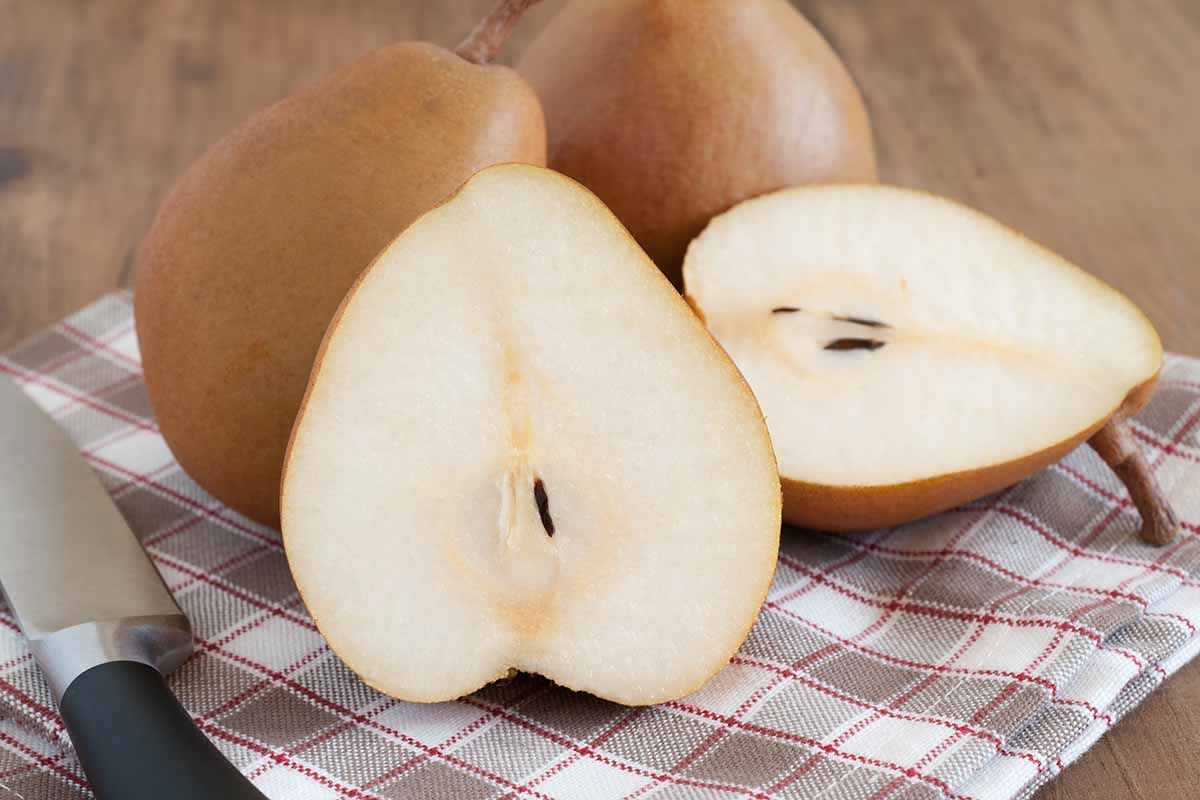
Either way, ‘Taylor’s Gold’ was found in an orchard in New Zealand belonging to a grower named Michael King-Turner in 1986. By 1998, it had arrived in the US.
The fruits are huge with a short, thick neck and a big, round base.
The golden brown skin has a hint of blush that makes it practically glow. The flesh is sweet and juicy after a short ripening period in cold storage off the tree.
Pair it with ‘Winter Nelis’ or ‘Warren.’
12. Warren
With short necks and an irregular base, this fruit has a funky shape hiding perfect flesh.
The juicy, buttery flesh has absolutely no grit with a sweet, spicy flavor even if you eat it slightly unripe straight off the tree.
We have the North American Fruit Explorers (NAFEX) to thank for some exceptional fruit trees and vital information.
This tree is named for one of the founders, Thomas O. Warren. He spotted this tree in Mississippi in 1976.
This is one of the best pollinators out there, thanks to its large and abundant flowers that persist for a long time, and can be used to pollinate any of the trees on this list.
Make one yours by heading to Fast Growing Trees for a three- to four- or five- to six-foot-tall tree.
13. Winter Nelis
There are some picture-perfect pears on this list that look every bit as good as they taste.
This isn’t necessarily one of them. ‘Winter Nelis’ isn’t going to win any beauty pageants, but don’t write it off.

The green and brown splotched skin almost looks like its overripe, but don’t let that fool you. Inside is a fragrant, smooth, juicy, sweet flesh. It’s perfect for fresh eating and cooking.
Named for its grower, horticulturist and pomologist Jean-Charles de Nelis of Mechlin, Belgium, ‘Winter Nelis’ reached England in 1818 and North America in 1823. It’s suitable for Zones 5 through 9.
Pair ‘Winter Nelis’ with ‘Concorde’ for cross-pollination.
You’ll Be Looking Forward to Winter
Winter has its charm, and for me, part of that is the abundance of juicy, sweet pears. You simply can’t find ones that taste like this during the summer and I look forward to them all year.

There’s no question in my mind why pears were once and continue to be a valued and treasured gift. They’re a rare treat for just a brief moment and then they’re gone again until next winter.
Which of these cultivars appeals to you? Will you be planting more than one variety from this list? Tell us about your pairing in the comments.
Once you have your winter options, you might have further questions about how to care for your pear trees. If so, these guides might be useful:
